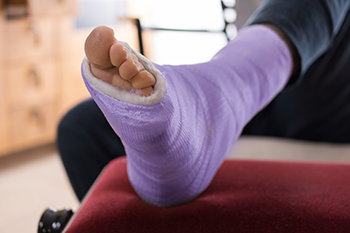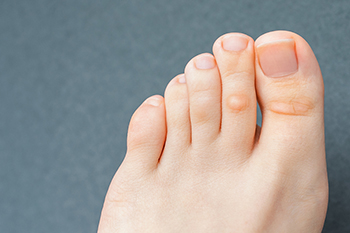Items filtered by date: October 2022
Foot Stress Fracture Symptoms

When an individual suffers a stress fracture, they essentially have developed tiny cracks in the bone, often due to repetitive or prolonged pressure. There are a number of different symptoms that are characteristic of a stress fracture. Namely, if you suffer from a stress fracture, you may develop bruising on the skin in the affected area. Typically, this might involve discoloration of some sort around the skin. The skin, for example, may appear to have a red, blue, or purple tint. Additionally, stress fractures may create poignant, localized pain at the site of the fracture. This pain can be worse when putting weight on the feet. Many individuals suffer from stress fractures—if you are one of them, consult with a podiatrist today.
Activities where too much pressure is put on the feet can cause stress fractures. To learn more, contact one of our podiatrists from Centers for Foot & Ankle Care. Our doctors can provide the care you need to keep your pain free and on your feet.
Dealing with Stress Fractures of the Foot and Ankle
Stress fractures occur in the foot and ankle when muscles in these areas weaken from too much or too little use. The feet and ankles then lose support when walking or running from the impact of the ground. Since there is no protection, the bones receive the full impact of each step. Stress on the feet can cause cracks to form in the bones, thus creating stress fractures.
What Are Stress Fractures?
Stress fractures occur frequently in individuals whose daily activities cause great impact on the feet and ankles. Stress factors are most common among:
- Runners
- People affected with Osteoporosis
- Tennis or basketball players
- Gymnasts
- High impact workouts
Symptoms
Pain from the fractures occur in the area of the fractures and can be constant or intermittent. It will often cause sharp or dull pain with swelling and tenderness. Engaging in any kind of activity which involves high impact will aggravate pain.
If you have any questions please feel free to contact one of our offices located in Merrillville, Portage, Michigan City/LaPorte, and Schererville, IN . We offer the newest diagnostic and treatment technologies for all your foot and ankle needs.
Rare Foot Conditions and Arches

The function of the feet is to provide balance and mobility to the body. This may be compromised when there are existing foot deformities. When the feet are positioned incorrectly, it may cause the body to move out of alignment and prompt medical attention is often sought. Incorrect foot positioning may be one of the first signs that specific foot conditions are developing and many of them have to do with an abnormal arch. Skew foot can happen when the arch loses its original position and this can occur from having unstable tendons and ligaments. Flat feet, which are also known as fallen arches, can produce pain and discomfort. It is noticeable as the inside of the foot is lower than the rest of the foot. Additionally, many children are pigeon-toed which forces the feet to point inward. Research has shown this condition is typically easy to correct. If you would like more information about various rare foot conditions, please consult with a podiatrist who can provide you with the information you seek.
Some foot conditions may require additional professional care. If you have any concerns, contact one of our podiatrists of Centers for Foot & Ankle Care. Our doctors can provide the care you need to keep you pain-free and on your feet.
Rare Foot Conditions
The majority of foot conditions are common and can be treated by a podiatrist. Standard diagnostic procedures are generally used to identify specific conditions and treatment can be rendered. A podiatrist also treats rare foot conditions which can be difficult to diagnose and may need extra attention and care.
There are many rare foot conditions that can affect children. Some of these can include:
- Freiberg’s disease
- Kohler’s disease
- Maffucci syndrome
Freiberg’s disease - This can be seen as a deterioration and flattening of a metatarsal bone that exists in the ball of the foot. It typically affects pre-teen and teenage girls, but can affect anyone at any age. Symptoms that can accompany this can be swelling, stiffness, and the patient may limp.
Kohler’s disease - This often targets the bone in the arch of the foot and affects younger boys. It can lead to an interruption of the blood supply which ultimately can lead to bone deterioration. The patient may limp or experience tenderness, swelling, and redness.
Maffucci syndrome - This affects the long bones in a child’s foot leading to the development of abnormal bone lesions. They are benign growths and typically develop in early childhood and the bones may be susceptible to breaking.
A podiatrist can properly diagnose and treat all types of rare foot conditions. If your child is affected by any of these symptoms or conditions, please don’t hesitate to call our office so the correct treatment method can begin.
If you have any questions please feel free to contact one of our offices located in Merrillville, Portage, Michigan City/LaPorte, and Schererville, IN . We offer the newest diagnostic tools and technology to treat your foot and ankle needs.
Gout Pain Can Be Managed
Three Types of Corns

Many people are surprised by the amount of pain that a corn can cause because they are so small. When they develop on the outside of the pinky toe, it can alter the gait or walking style, and can be quite uncomfortable. This type of corn generally occurs from wearing shoes that do not fit correctly, and the pain may gradually subside when a protective covering is worn over it. If it is severe, and causes difficulty in completing daily activities, it may have to be surgically removed. Corns can fit into three categories. A corn on the pinky toe is considered to be a hard corn. This type of corn is the most common, and can also develop on the tops of the toes, or on the balls of the feet. Having dry skin may produce seed corns, and these are often found in clusters. Soft corns are rubbery in texture, and can be found between the toes, which can be a result of the moisture from sweat that can accumulate there. It is beneficial to wear shoes that are larger, which may help to accommodate the corn, and relief may be found when the shoes provide adequate shock absorption. If you have developed corns of any type on your feet, please confer with a podiatrist who can effectively treat this foot condition.
If you have any concerns regarding your feet and ankles, contact one of our podiatrists of Centers for Foot & Ankle Care. Our doctors will treat your foot and ankle needs.
Corns: What Are They? and How Do You Get Rid of Them?
Corns can be described as areas of the skin that have thickened to the point of becoming painful or irritating. They are often layers and layers of the skin that have become dry and rough, and are normally smaller than calluses.
Ways to Prevent Corns
There are many ways to get rid of painful corns such as wearing:
- Well-fitting socks
- Comfortable shoes that are not tight around your foot
- Shoes that offer support
Treating Corns
Treatment of corns involves removing the dead skin that has built up in the specific area of the foot. Consult with Our doctors to determine the best treatment option for your case of corns.
If you have any questions please feel free to contact one of our offices located in Merrillville, Portage, Michigan City/LaPorte, and Schererville, IN . We offer the newest diagnostic and treatment technologies for all your foot and ankle needs.
Painful Morton’s Neuroma

The feet are known to absorb more force than any other body part. There are many foot conditions that can cause extreme pain and discomfort, and Morton’s neuroma falls into that category. It is defined as a compressed nerve that lies between the third and fourth toes, and can happen from wearing shoes that do not have enough room for the toes to move in freely. Women who wear high heels may develop and suffer from Morton’s neuroma, and if it is not diagnosed promptly, surgery may be needed for permanent relief. Early detection of this condition may help the inflamed tissue surrounding the nerve to stabilize, and wearing shoes that fit correctly may help to accelerate this process. Morton’s neuroma can become a serious foot condition, and if you feel you have this, it is strongly advised that you are under the care of a podiatrist who can properly assess and treat this ailment.
Morton’s neuroma is a very uncomfortable condition to live with. If you think you have Morton’s neuroma, contact one of our podiatrists of Centers for Foot & Ankle Care. Our doctors will attend to all of your foot care needs and answer any of your related questions.
Morton’s Neuroma
Morton's neuroma is a painful foot condition that commonly affects the areas between the second and third or third and fourth toe, although other areas of the foot are also susceptible. Morton’s neuroma is caused by an inflamed nerve in the foot that is being squeezed and aggravated by surrounding bones.
What Increases the Chances of Having Morton’s Neuroma?
- Ill-fitting high heels or shoes that add pressure to the toe or foot
- Jogging, running or any sport that involves constant impact to the foot
- Flat feet, bunions, and any other foot deformities
Morton’s neuroma is a very treatable condition. Orthotics and shoe inserts can often be used to alleviate the pain on the forefront of the feet. In more severe cases, corticosteroids can also be prescribed. In order to figure out the best treatment for your neuroma, it’s recommended to seek the care of a podiatrist who can diagnose your condition and provide different treatment options.
If you have any questions, please feel free to contact one of our offices located in Merrillville, Portage, Michigan City/LaPorte, and Schererville, IN . We offer the newest diagnostic and treatment technologies for all your foot care needs.

